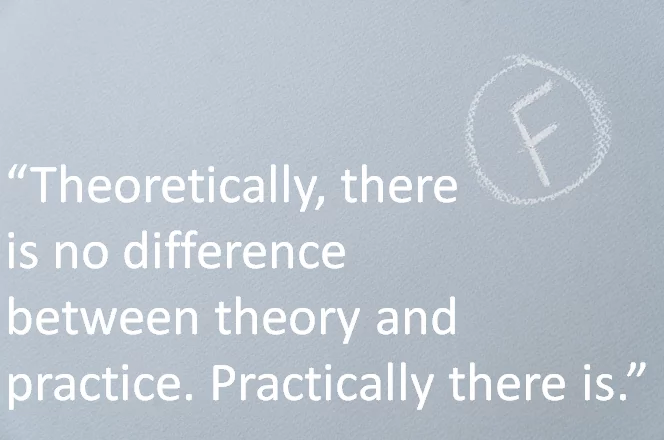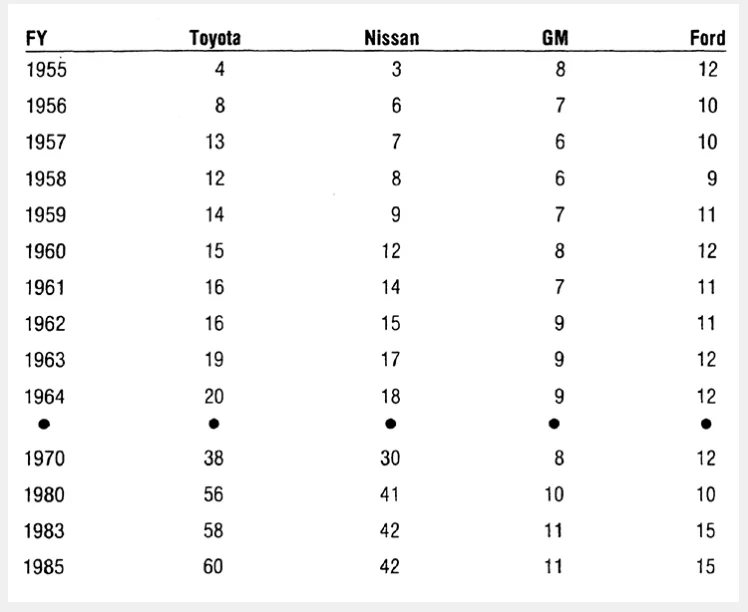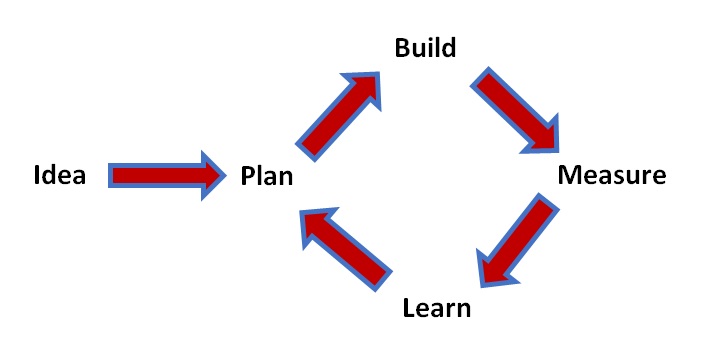Startups are young businesses that are founded in order to introduce new and innovative products to the market as quickly as possible. The founders of such a company are usually confronted with limited resources and considerable uncertainty about the viability of their intended business model. This makes it even more important to keep the investment of time, money, and nerves (as well as the associated risks) within manageable limits. At the same time, however, the project should yield its first results better yesterday than tomorrow. This is a balancing act that challenges committed young entrepreneurs with high obstacles. Often too high ones – as between 80% and 90% of German startups fail within the first three years. A strategy that is supposed to help reduce the uncertainty factors and increase the survival rate of new businesses is the so-called Lean Startup.

In this article, you will learn:
- what exactly the term “Lean Startup” means,
- which principles it is based on
- and how you can implement them in practice to get your business idea off to a successful start,
Table of Contents:
- The Lean Startup Method (What is hypothesis-driven entrepreneurship?)
- Know your audience (Is your product fit for the market?)
- Create MVPs to test your hypotheses (Learn from mistakes, grow with achievements)
- The success spiral: plan, implement (build), measure (plus learn), and repeat
- The Lean Startup Canvas as PDF download
1. The Lean Startup Method (What is hypothesis-driven entrepreneurship?)
The basic idea of the Lean Startup originates from Eric Ries and was perfected by him over several years in numerous of his own projects. In 2011, he was finally able to publish the workable theory in the book “The Lean Startup: How Today’s Entrepreneurs Use Continuous Innovation to Create Radically Successful Businesses.” Born in 1978, Ries already showed his ambition and entrepreneurial spirit while studying computer science at the renowned Yale University. As an undergraduate, for example, he and some of his fellow students founded Catalyst Recruiting: an online forum for networking between students and potential employers. Although this first project was a failure, it did not discourage the young Eric – but did quite the opposite actually. Several more projects were about to follow, as well as his theory of the Lean Startup, based on the experiences of them.
His inspiration for this concept was the model of lean production. This in turn had been developed by the Japanese car manufacturer Toyota (in the person of Taiichi Ōno) in the fifties of the last century in order to catch up on the productivity gap between the Japanese and the US car industry. It ended up being very successful indeed, considering that in 1959 Ford could produce up to 7,000 vehicles a day at its Detroit plant – while Toyota had produced only 2,685 vehicles in thirteen years (!). By 1980, however, the tide had turned dramatically due to Japanese lean production. At that time, a Ford delegation in a Japanese Mazda plant had to note enviously that cars comparable to theirs were already being manufactured there and in addition, with only 60% of the effort and far fewer quality problems.

Like the Lean Production on which it is based, the theory of the Lean Startup equally focuses on streamlining the development and production process. In addition, production (and thus the product) is continuously adapted to changing consumer wishes and market conditions. This not only significantly reduces the use of resources, but also minimizes the risk of developing a product that does not meet market requirements. In other words, disregarding the wishes of the designated group of buyers during the process of development. Unfortunately, this is an all-too-common mistake and one of the main reasons for the failure of startups.
2. Know your audience (is your product fit for the market?)
Too often, the standard advice for starting a business is to write a business plan first and foremost. However, such a plan is purely about the execution of the business idea – how to plan, produce and sell the product. The assumption that it may not even meet the requirements and desires of consumers is completely left out.
If you have a business idea – as good as it may be – the first step should not be to create a plan to implement it. Rather, you should conduct a market analysis to answer the following three basic questions:
- Does there even exist a problem in your target group that you can solve with your product?
- Is the target group willing to spend money to solve it? (And if so, how much approximately?)
- And last but not least (or actually most important) – is your product the solution they expect?
As mentioned earlier, product-market fit is among the most common reasons for startups to fail. Just because you think everyone will love your idea as much as you do – so much that he or she is even willing to pay money for it – doesn’t necessarily mean that this reflects the reality.
The first question for validating your business idea should therefore not be “How do I implement my idea?”, but:
“What information do I need to ensure that the problem I am targeting is, first, really. And that secondly, my target group is therefore willing to pay for my proposed solution?”.
So instead of writing a business plan as the first step of starting a business, we encourage you to follow the Lean Startup process to validate your business idea. In the end, it’s better to figure out at an early stage that you need to change your approach rather than invest time, money, and energy in developing a “solution” that no one needs.

For this purpose, a lean startup works with so-called MVPs (Minimum Viable Products). The principle behind this is to introduce the product to the market as quickly as possible and with as little investment as possible – in order to obtain feedback from early adopters at an early stage of the developmental process. The method, therefore, propagates a launch with a functional prototype instead of a market entry with a “100% perfect (but possibly faulty) designed product”.
3. Create MVPs to Test your Hypotheses (Learn from Mistakes, Grow with Achievements)
A Minimal Viable Product is the first version of a product that is basically functional, but with no more functions and/or features than are absolutely necessary for it to work. In this form, however, it can already be released and further developed on the basis of real customer feedback. This ensures that only the features that are desired or accepted by users are added at a later stage.
The MVP is therefore a scientific process of data-driven product development that aims to test theoretical hypotheses. It is based on the principle of “validated learning”, which can best be described by the phrase “learning by doing,”. In contrast to market research, which is often subject to errors, customer wishes and behavior can thus be directly experienced by the developers, since the data basis is not only based on oral statements that can be easily influenced. This input can thus be implemented 1:1 in development and production without having to fear embarrassing (as well as expensive) mistakes. The result is a product that is lean, but at the same time fully satisfies user requirements, and is resource-saving, user-friendly, and optimized in its applicability.
For example, when Zappos became one of the first online stores ever to start selling shoes online in 1999, they created a simple website, went to the nearest shoe store, took photos and uploaded them to their store. Once an order came in, they bought the particular item from the shoe store and delivered it to the buyer. The success of this cheap, controlled, and expectation-free MVP-experiment validated the idea of the Zappos founders’ of being able to successfully sell shoes online.
To recap:
- An MVP is about validating a theoretical business idea.
- The MVP helps to mitigate the risk of an upfront investment, while at the same time being able to develop the complete service that will subsequently be needed for the final product.
- The MVP enables the execution of a large number of experiments in short periods of time. This increases the chance to find the optimal product-market fit.
Of course, the development process of a Lean Startup itself is not free of errors. The difference, however, is how these are handled. They are not seen as failures, but as an incentive for further improvement. They also provide valuable information for the further development of both the product and the company. After all, it is no coincidence that the repetitive cycle of the lean startup method is described by the words “plan, build, learn, repeat”.

4. The Success Spiral: Plan, Implement (Build), Measure (Plus Learn), and Repeat
This chapter concludes with a brief and clear summary of the most important steps – as well as their practical implementation – of the Lean Startup Method.
Step 1: Plan
Your first task is to define the idea you want to test as well as to determine the information you need to gather for this purpose. To do this, you must develop a lean hypothesis: a prediction about what will happen during the experiment. Next, you determine what you need to measure to test your hypothesis – and most importantly, how you will collect that data.
In the case of a product or business idea, the hypothesis is that you will solve a problem of your target audience with your product offering. To test this, you confront your future customers with an unfinished prototype (or an even more rudimentary basic version) of your product (MVP). Based on the feedback of the users, you continuously develop this MVP into a perfect solution.
Step 2: Implement / Build
You start with a Minimum Viable Product – the smallest possible product with which you can test your hypothesis. This can be an already working prototype, but also a simple ad or landing page. Even something as simple as a presentation slideshow, brochure, sample dataset, storyboard or video can be sufficient. Provided it illustrates convincingly enough the product you are planning to offer. Whatever MVP you choose, it needs to show just enough core functionality to capture the interest of early adopters. That is, the group of people who would most likely buy your product right after its launch.
For example, the first 5,000 users signed up for the cloud-based file-sharing provider Dropbox even before the actual launch of the service. They were convinced solely by the MVP – a 90-second video explaining the service Dropbox wanted to offer.
Step 3: Measure (and learn from it!)
Verify the results you got in step 2:
- How does what actually happened compare to your hypothesis?
- Is there enough interest in your idea to further develop it?
- Does the data show that you are going to be able to build a sustainable business around your product?
The answers to these questions should tell you how to proceed with your idea. In principle, there are two ways to do this – but both will lead you to the following
Step 4: Repeat
Possibility A: Pivot (change your mind – who would want to give up so quickly?)
The first experiments may have disproved your hypothesis that your product idea would be a real problem solver. But you still gained valuable insights into what doesn’t work. This allows you to easily reset or course-correct to repeat the loop. On the second try, you use what you’ve learned to test new hypotheses – until finally, one leads to the desired success.
You can pivot in different ways. For example, you can
- Develop a single feature from your MVP (called “zoom-in pivoting“),
- focus on a different target group (“customer segment pivoting“),
- try to be more successful via a new sales channel (“channel pivoting“)
- or use a single feature as the basis for a new product (“zoom-out pivoting“).
Option B: Persevere (Continue)
Your hypothesis was correct (congratulations), so you decide to continue with the same product. To do this, you repeat the feedback loop over and over again to continuously improve and refine it.
BUT: Even if your idea has achieved enough initial success to stick with it, you should always keep in mind that this may not be the case in the next round of extensions. Therefore, be prepared to pivot in the future. However, never forget that small setbacks or mistakes are part of the learning process – and should therefore never be seen as a failure. Rather you should see them as a further step towards the perfect problem solution in the form of your product.

5. The Lean Startup Canvas as PDF Download
The Lean Startup Canvas is an adaptation of the Business Model Canvasby Alexander Osterwalder adapted to Lean Startup spirit (Fast, concise and effective). With the Lean Startup Canvas, you can easily document
- your hypotheses,
- experiments
- and the resulting learnings,
- as well as your progress.
That brings us to the end of our article on the Lean Startup Method – and how you can use it to validate your business idea. If you want to dive deeper into the topic, we recommend that you read the Harvard Business School article “Hypothesis-Driven Entrepreneurship: The Lean Startup“. We hope the information and practical examples listed here will be helpful for you in building your own startup (if you plan to found one). If you need any assistance, we invite you to contact us and use our experienced team for your product development – we look forward to hearing from you. This way you save valuable time for your launch, which you can, in turn, invest in building your own team. So that you can manage your next product development completely in-house!



